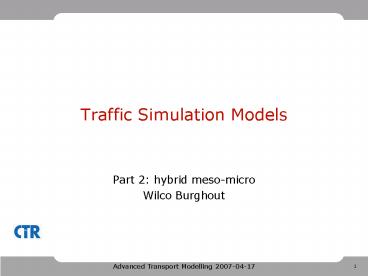Traffic Simulation Models - PowerPoint PPT Presentation
1 / 21
Title:
Traffic Simulation Models
Description:
... takes less time to code network, routing over entire network, fast simulations. ... abs. ( veh/h) New Control (veh/h) Old Control (veh/h) From. Difference ... – PowerPoint PPT presentation
Number of Views:158
Avg rating:3.0/5.0
Title: Traffic Simulation Models
1
Traffic Simulation Models
- Part 2 hybrid meso-micro
- Wilco Burghout
2
Contents
- Why hybrid simulation?
- What is hybrid simulation?
- How did you do it?
- Application Londonviadukten, Södermalm,
Stockholm - Can you show it?
- So how did it go?
- And what are your conclusions?
3
Why hybrid simulation?
- Micro models
- Good for small areas, with much detail, e.g. to
study signal control in a number of intersections - Not so good for large areas. Difficult to
calibrate, network coding takes a lot of effort
and time, and simulations are slow. - Meso models
- Good For large areas, less detail, e.g. an entire
city. Easier to calibrate, takes less time to
code network, routing over entire network, fast
simulations. - Not so good for detailed studies, such as
adaptive signal control, merging areas etc.
4
Hybrid meso-micro simulation
- Integrates meso- and micro models to
- Simulate a small area (or multiple small areas)
in detail with micro simulation - Simulate surrounding area with meso simulation
- Allows study of local effects of traffic
operations, e.g. adaptive signal control with
micro, and network effects with meso - Realistic inflows into micro from buffer network
in meso, incorporating queue propagation over
meso-micro boundaries. - Can capture redistribution effects of local
changes, where traffic may avoid the micro area,
or new traffic may be attracted to the micro area.
5
Hybrid modeling consistency
- Consistency in route choice and network
representation - Consistency of traffic dynamics at meso-micro
boundaries - Consistency in traffic performance for meso and
micro submodels - Transparent communication and data exchanges
6
Hybrid framework
7
Network representation Virtual links
8
Traffic dynamics at meso-micro boundaries (1)
- Micro Meso Virtual vehicle(s)
- Virtual vehicle
- Last vehicle that exited on that lane
- Speed, distance from meso
- Uses existing car-following logic in micro
Micro
Meso
9
Traffic dynamics at meso-micro boundaries (2)
- Meso Micro
- Micro density for Meso shockwaves
- Vehicle loading
- Arrival Time headway
- from Meso stochastic queue server
- Lane
- Based on lane restrictions (e.g. buslanes), route
continuation and available space - Speed
- Loading mechanism
10
How did we do it?
- Meso MEZZO (developed at CTR, KTH)
- Micro VISSIM (PTV AG)
- Methods Burghout (2004), Hybrid traffic
simulation, PhD Thesis - Adapted to the possibilities of VISSIM COM
interface - PTV has adapted and developed COM interface for
our needs.
11
How does it work?
- MEZZO simulates entire Stockholm area (6000
links), generates traffic from Origin-Destination
(OD) matrices. - Micro area (VISSIM) cut out of meso (MEZZO)
network. - Replaced by virtual links, that send cars that
come to the boundary from MEZZO to VISSIM and
vice versa. - Queues propagate over boundaries between MEZZO
and VISSIM - Cars in VISSIM that approach boundary to MEZZO
gradually get an adapted speed, according to the
downstream speed in MEZZO
12
Application, background
- MATSIS Project better environment with improved
signal control. Micro simulation with VISSIM
EC1-simulator tool for evaluation - Results with micro only new (adaptive) signal
control drastically reduces queues. But would it
draw additional traffic from other routes? - Study possible traffic redistribution effects of
the improved signal control using hybrid
simulation
13
Application, Londonviadukten, Stockholm
1
2
3
Source Google Maps
14
Application, how did we put it together?
- MEZZO network converted from a CONTRAM network of
Stockholm (6000 links, 300 zones, 20.000 active
OD pairs) - VISSIM network adapted from MATSIS project
- Adaptive traffic control, incl. bus priority
simulated with EC1 signal controller simulator
exact same control as on the street.
(software-in-the-loop)
Vehicles
Signal group status
Signal controller simulation (EC1-simulator)
Meso simulation (MEZZO)
Micro simulation (VISSIM)
Traffic Conditions
Detector status
15
What does it look like?
16
Map micro area
Slussen
Folkungagatan
Nacka
Tegelviksgatan
17
Application, preliminary results. Flows through
micro (VISSIM) area
18
Application, preliminary results. Results micro
(VISSIM) area
19
Application, preliminary results. Travel times
in MEZZOVISSIM
20
Conclusions
- Hybrid meso-micro model MEZZO VISSIM
- Application effects of new signal control
Londonviadukten - Preliminary results
- Better throughput for micro area with new signal
control (VISSIM) - Shorter travel times even for the surrounding
network (MESO) - Better signal control in micro area attracts
extra traffic from surrounding area, but net
effects are still positive. - With hybrid modeling we could study
- Local effects of signal control, old vs. new
- Network effects for OD travel times
- Redistribution effects due to increased
throughput with new control
21
In the future we will
- calibrate the meso model better and estimate
better OD matrices to get more reliable flows for
the rest of the network - add buses, bus lanes, bus stops and time tables
to MEZZO to be able to simulate the bus
operations realistically for the entire network - will apply the hybrid model to other networks
where both local and network effects need to be
studied - will parallelize MEZZO and MEZZO-VISSIM to be
able to run on multiple computers































